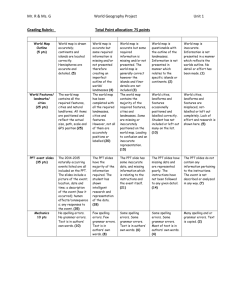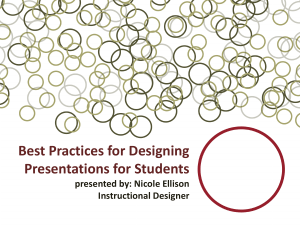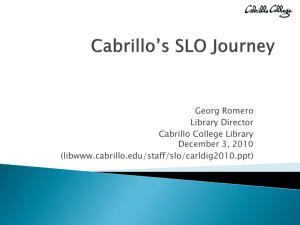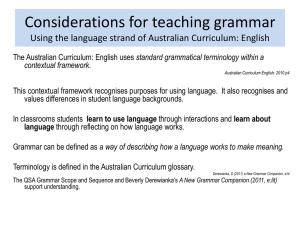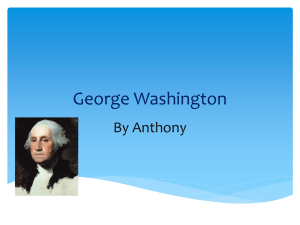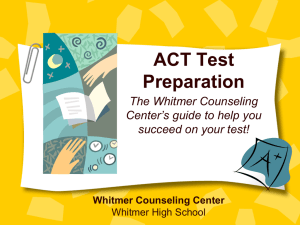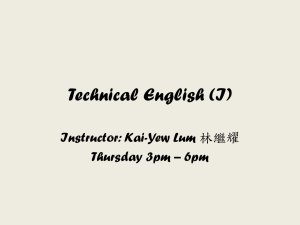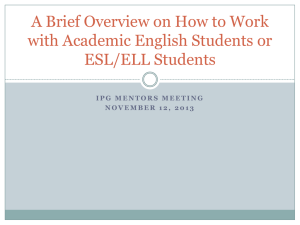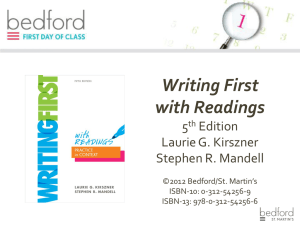E = Encounter
advertisement
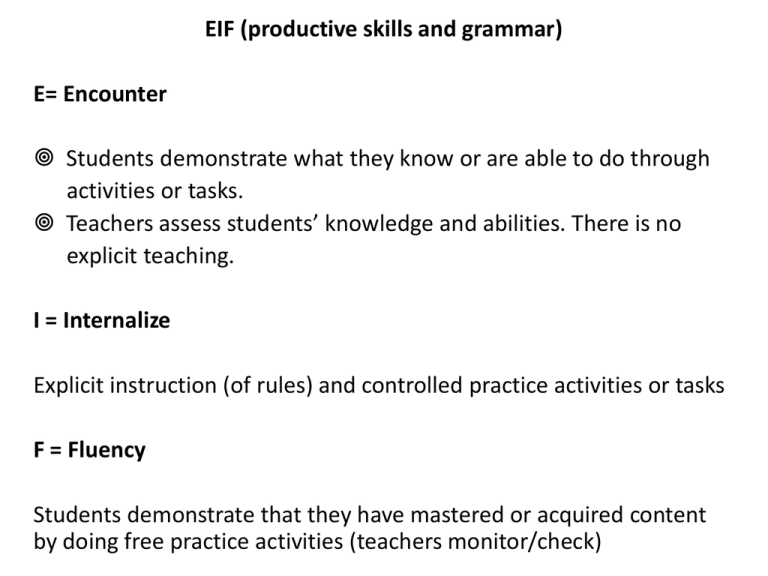
EIF (productive skills and grammar) E= Encounter Students demonstrate what they know or are able to do through activities or tasks. Teachers assess students’ knowledge and abilities. There is no explicit teaching. I = Internalize Explicit instruction (of rules) and controlled practice activities or tasks F = Fluency Students demonstrate that they have mastered or acquired content by doing free practice activities (teachers monitor/check) Present perfect (pp.33-45) 1 2 3 4 5 6 7 8 9 E E E E/I I I I I F PPT pictures (e.g. love at first sight) > “Have you ever…?” “Card Attack” (base form > simple past > past participle) Human sentences (correct order) Scrambled sentences + figure out present perfect rules 3 statements, 3 questions > Pass the monkey “Find Some Who” (statements, questions > present perfect) Handout (p.44) > compare present perfect and simple past “Talkopoly” (p.45) Travel reporters > interview classmates Who are they talking about? (English Firsthand 1) 1 2 3 4 5 6 7 8 E E I I I I F F Getting ready > sort words to describe people into groups Describe your partner, teacher, and famous people Check unknown lexis from steps 1-2 (e.g. cool patch) Conversation (T-Ss) > pictures of Scott’s friends Information gap pair work > bank robbers (man, woman) Language check > grammar and lexis Draw a picture of your family and describe them Prepare a short presentation > picture of you and friends Title or explanation Present perfect Level/Age Intermediate/High school students and adults Time 60 minutes Language focus Skills > speaking and grammar Grammar > past tense vs. present perfect Vocabulary > *None Student learning objective [SLO] By the end of the lesson, students will be able to use present perfect and simple past to ask questions and make statements about their past experiences by doing a class interview activity Assessment Students will writie the rules for the differences between simple past and present perfect, and then use the correct form in a game of “Talkopoly” and in the interview activity Students’ background knowledge and abilities The vocabulary used in the activities and the forms of both verb tenses Challenges and solutions Challenges> coming up with the rule instead of being given the rule; when to use the two different verb tenses in different situations Solutions > give lots of opportunities to discover the rules through inductive-based activities/examples, working in pairs so students can learn from each other, and writing the rule on the board once they create it Materials PPT pictures of experiences (e.g. fall in love at first sight) Cards (base form verbs) and game board for “Card Attack” Scrambled sentences (paper or PPT) Guiding questions (x2) for present perfect form vs. simple past “Find Someone Who” handout (past experiences) “Talkopoly” game board (present perfect or simple past) Steps 1, 2, 3, etc. Stages E, I, F Time Approximately how long each step will take (e.g. 5-7 minutes) Procedure Clear, concise explanations of what students will do for each step Interaction T-Ss (teacher-students), Ss-Ss (students-students – i.e. pair work, group work, or whole class work) Step or task purpose An explanation of why the step is needed (e.g. to raise interest and activate background knowledge in order to prepare them for the new information) Procedure – What teachers can do Elicit (get students to tell you) Divide students in to pairs or groups Model (clearly demonstrate/show how to do the task vs. tell) Get feedback (to check on task achievement) Use focusing questions (to focus on the task or target language) Use guiding questions (to help facilitate the task) Use CCQs (to check if students know how to do the task) Provide scaffolding (to support/make task easier for students) Erase, take away clues Remove target language support Comprehension check questions (CCQs) Check if students understand what they are supposed to do for a given task or step (versus “Do you understand?” “Got it?” “Clear?”) Examples What are you suppose to do? What do you do first? Second? What are you not allowed/supposed to do? Do you do this alone or together? How much time do you have (to complete the task)? Short Form T = Teacher SLO = Student learning objective S = Student i.e. = that is Ss = Students e.g. = for example TL = Target language e/o = each other NA = Not applicable w/ = with Q&A = Question and answer b/c = because PPT = PowerPoint WB = Whiteboard SL = Sample lesson SWBAT = Students will be able to VAKT = Visual, auditory, kinesthetic, tactile FMU = Form, meaning, use E = Encounter (Activity Purpose) Establish and build rapport, friendly atmosphere Activate background knowledge/schema Initial assessment (check form, meaning and/or use) Check if students are ready to acquire target language Raise interest and motivation Introduce the topic Review previously learned grammar point Expose students to target language Inductive process is used to discover grammar Students are provided with visual support of new words (PPT) Different learning modalities/channels are appealed to (VAKT) Opportunities for peer learning and teaching I = Internalize (Activity Purpose) Controlled and less controlled (freer) practice Create comfortable and safe environment New language is introduced and practiced Learner attention is drawn to features of target language Students demonstrate form, meaning and use of target language Repeat key vocabulary Scaffolding is provided to assure student success Sustain interest and motivation Modeling helps students clearly understand what to do Accommodate different learning modalities/channels (VAKT) Affective factors are accounted for Practice is made fun, encourages active participation Students are given a chance to clarify their understanding Silent period helps students get comfortable with new form F = Fluency (Activity Purpose) Students demonstrate student learning objective Students show that they are able to be active in own learning Students are given autonomy to use the target language Authentic purpose in using the target language is provided Students personalize the material Students communicate freely (free practice of target language) Opportunities for outcome feedback are provided Comparatives (pp.13-21) 1 2 3 4 5 6 7 E E E/I I I I F Famous Korean entertainers Review/Brainstorm (vocabulary – describing people) Puzzle game (logic puzzle on PPT) Next chunk – Q form (Is A ___ B?) Checking form (T models chart on WB) Less controlled practice (Korean entertainers > Q form) Survey (Famous Koreans > 3-5 questions, mingle) Comparatives 2 (pp.22-32) 1 2 3 4 5 6 E E/I E/I I I F Review (Is A ___ B?) + New stem (less/more) “Structures 1” (p.30) “Look and Say II” (p.29) “Works in pairs” (p.29) Compare places and famous people in Korea Consent game (p.31) > compare people and things Can/Can’t (pp.47-55) 1 2 3 4 5 6 7 8 E E E E/I I I I F What do you like to do? > play, do, go Review/Brainstorm > What is s/he doing? Matching game > action verbs Introduce target language > Can you ___? (can/can’t) Checking form > correct and incorrect sentence on WB Cups, flash cards, and X-O game Go fish game > 32 flash cards (match) Survey > five actions Locator prepositions (pp.56-62) 1 2 3 4 5 6 7 E E/I I I I I F Greeting and introduction T introduces locator prepositions (e.g. Where is the pen?) Ss practice pronunciation and sound linking Ss follow T commands (e.g. Put your pen on the desk.) Survey > objects in the classroom Information gap > picture, objects Drawing activity > picture on the board, objects, draw Life Map (pp.63-71) 1 2 3 4 5 6 E E/I I I I F Small group discussion > important life events Lexis discussion and matching activity Life Map – Task 1 > make a list of important life events Life Map – Task 2 > count and order life events Life Map – Task 3 > Make a life map Sharing Life Map How to develop a lesson Overview (where students going, how get there, know when arrived) Goals (aims, language skills, lesson tie in with course framework) Requirements (title or explanation, level and age, time) Prerequisites (what students must know, challenges envisioned) Materials (items, prep time, instructions, learning styles) Lesson – Introduction (introduce aim, raise interest, assess knowledge) Lesson – Main (coherent sequence of steps, facilitate learning) Closure/Conclusion (wrap up and provide feedback) Follow-up lessons (homework, next steps of tasks/activities) Assessment/Evaluation (check if SLO was achieved)

